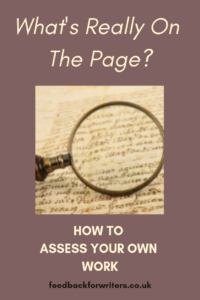
How do you know if what you think you’ve written is what you thought you had? Could your mystery masterpiece be devoid of mystery, your heartfelt drama be worthy of an oft-derided soap opera, your heroic characters be coming across as flat or pretentious, your clear riff on a classic myth missing any discernible links to the original for your readers to get their teeth into?
Happens to the best of us,of course.
So what’s the solution?
Summarising the story as is has been the single most useful way I’ve found of of forcing myself to distance from the work and see what is really there, rather than what I hope is there. It does take a bit of discipline, however.
STEP 1
When you’re ready, and preferably when some time has passed since you wrote it sit down and read your story or chapter through once. Do not start editing and fiddling. Do not pass Go. Just sit and read it through.
OK? Done?
How was it?
If there is anything that struck you about the piece there and then, a major flaw for example, make a note somewhere but put it aside for now. You can deal with it later.
Take a deep breath. What do you reckon? What did you think of it?
A. You’re horrified at what you just read and think it’s crap?
Doesn’t matter. That’s why you’re working on it now
B. So-So – you like some parts but can already see some areas that will need work?
Completely normal, and the work that needs to be done can range from the “extreme” to the “needs a few tweaks”. Either way, you need to give yourself a roadmap for how you’re going to move forward with it next.
C. You’ve just surprised yourself with how good it is?
Great! Bask in that feeling for a bit. It’s a fantastic feeling of achievement and satisfaction that should be celebrated. It’s the Holy Grail. Enjoy.
And when you’re done enjoying, and assuming of course that you have not already decided that this piece is ready to go (it may be) carry on with that little extra bit of work to help make sure it is going to be as good as it can be.
STEP 2
From memory, write a short summary of what you saw written on the page of the story from start to finish. (NB if this doesn’t work and you start putting what you want the events to be in it, stop. Swap with another writer, get them to do the summary. Do not ‘pitch’ your story – this isn’t the time and this is a task for later anyway. Right now, we are all about pragmatism. This is about what IS , not what might be).
Imagine if you can that this is someone else’s story. Your summary should be about 500 words.
For example (first lines of a summary of one of my own stories):
A young woman called Eva is driving a hired car on a motorway. She is tense – the tightness of her coat and boots are mentioned – and she seems to be running away from something. On the road, she is passed by other cars that seem threatening – ‘lights like eyes, looming’ – and she is unnerved by a middle aged male driver seemingly yelling swear words at her as he drives past. A shaken Eva pulls into a lay-by and checks her directions on a piece of paper. She is on her way somewhere as yet unrevealed, but there is ‘a woman’ mentioned whom Eva seems to be late for…
Carry on until you’ve reached the end of your story. Don’t peek at it again just yet, just try and remember.
How much of it did you get?
The purpose of this exercise
This is about picking up on the most salient features of what you have on the page.
Ask yourself this: How many times is a reader going to be reading your story? With a film, you really only have one chance; fiction readers, particular of short stories, may well read more than once just for the pleasure of it, but unless you’re one of their favourite writers, you can’t expect that they will go over it again and again. With novels – even less likely, and someone going through a slush pile will certainly not be bothering to read it more than once. So getting a feel for those salient features and the one chance you have to grab them are crucial.
Now, read the story again more slowly, and fill in any essential gaps.
Do NOT analyse – now is not the time for this. This is all about What Is There Now.
This kind of summarising is different from creating a logline, which is something we’ll look at separately. Creating a logline is a way of actively creating a spine for your story which you can then use as a guide while you are writing.
Doing a summary of what is already there is showing you what is already in the work. It gives you Big Clues as to the overall picture of the work , where it is currently succeeding, and the areas you might have to work on to improve it.
Now go and get a cup of tea.
In the next post, I’ll be looking at some of the most common problems to look out for at this stage – and what you can do about them.
How do you get distance from and assess your work? Feel free to leave comments below.

One Reply to “What’s Really On The Page? How To Assess Your Own Work”
Comments are closed.